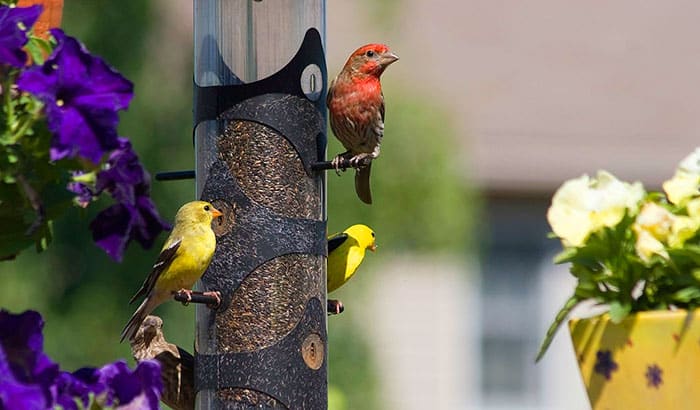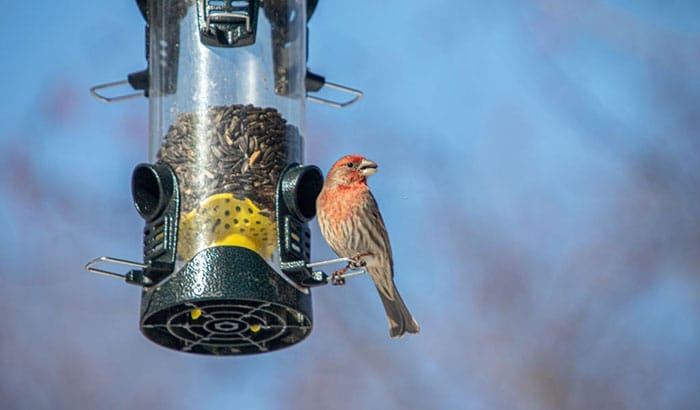I love having birds in my backyard without having to cage them. With the help of a bird bath and a few bird feeders, I get to see a wide variety of birds come and go. But one bird species I found finicky and hesitant to visit my property is the finch. I looked for ways to attract finches into my yard. And I discovered ways on how to make a finch feeder as well as attract the little animals.
Why are Finches Hesitant to Visit Bird Feeders?
From what I’ve seen of finches, they are extremely wary of danger almost to the point of paranoia. This may be because of their tiny and defenseless bodies. This may be the reason why they are not too happy to visit feeders where potential predators can see them.
I tried different strategies to get finch feeders to visit my property. Here are the steps that I’ve proven effective.
Contents
How to Build a Bird Feeder that for Finches
Though I can buy a “professionally designed and made” bird feeder in pet stores or online, making them myself is cheaper, I discovered. Plus, I had the chance to integrate my personal touch into the feeder.
Finches prefer eating upside-down. There are three bird feeder designs that can accommodate their unique eating habits, sock, platform, and tube feeders. But of these three, I find that the tube feeder works best to attract finches.
Materials Needed:
- 2-liter water bottle or any other plastic bottle
- Metal screw hook
- String
- Polyurethane glue (such as Gorilla glue
- 8 to 10 inches long and about 1/4 inch thick perches (can be dowels, chopstick, or twigs)
- Colorful ribbons
Tools Needed
- Drill, awl, or any other puncturing tool
Step 1: Clean the Bottle
Finches are very picky. They don’t want to go to feeders that are unclean or moldy. Cleaning the primary seed holder is a very important first step.
I first remove the label. Then I use a weak bleach solution to sanitize the bottle. Making sure that the bleach solution is not too strong s important. I don’t want to poison the finches with chemicals. I thoroughly rinse the water bottle then let it air dry for several hours.
It’s important to make sure that there is no moisture in the bottle. It will spoil the seeds faster.
Step 2: Add Perches
Cut holes along the side of the bottle for perches. The holes should be in pairs, one on each side of the bottle. They should also be big enough for the perches to fit in snugly. Insert the perch completely across the bottle and out the matching hole on the other end. I make sure to balance the length of the perch on both ends before using glue to secure it.
I add more perches if I have enough space. Each additional perch is about three inches higher or lower from the other. I also rotate them around the bottle to provide maximum space for the finches.
Step 3: Cut Feeding Holes
Using the awl, I cut feeding holes 1 to 2 inches above and below the perches. This accommodates the upside-down feeding style of finches. Depending on the type of seed I’ll use (more on this later), the holes should be 1/8 to 1/4 inch wide. Feeding holes taller than they are wide are easier for birds to feed on.
Step 4: Secure the Metal Screw Hook on the Bottle Cap
Using an awl or a drill, I make a small hole in the bottle cap. Then I screw in the metal hook. I use the glue to secure the hook and make sure that it is secure. The glue also helps keep the moisture out of the bottle. I’m careful not to put glue on the cap threads, though. I need to be able to screw the cap on and off the bottle when refilling the seeds.
Step 5: Fill with Seeds
An interesting observation I’ve had was that finches prefer fresh black seeds over other bird foods. They always choose seeds with a strong black color, like thistle seeds or black oil sunflower seeds. They ignore brown and old-looking seeds.
What’s more, they can tell the difference between old seeds and fresh seeds. I’ve found it useful to buy seeds on an as-needed basis. I discovered that it’s best to buy seeds that the birds can consume within less than a month.
Step 6: Place the Feeder Where the Finches Feel Safe
As I have already mentioned before, finches are small birds that are wary of danger. By placing the feeder in an area where finches naturally feel safe, the chances of drawing them in increase.
A feeder out in the open makes finches feel exposed and vulnerable to predators. Hanging the feeder near a shrub or a tree makes finches feel safe enough to visit the feeder. However, they might still be in danger of squirrels or chipmunks. I strongly advise taking steps to keep these rodents out of the feeders.
Use the string to attach the feeder to a tree or bush. Make sure that the feeder is far enough from the trunk so that squirrels can’t jump horizontally to it. The string also protects the feeder because it is too thin for rodents to navigate up and down on. A baffle may be necessary, but it is optional.
Step 7: Splash a Bit of Color on the Feeder
This is one of the reasons why I prefer making my own finch-friendly feeder. I discovered that fiches are attracted to colorful feeders. Adding a brightly colored ribbon on the feeder attracts more finches. Perhaps it looks safe for the finch because what looks like a bird is already on the feeder.
Also, I discovered that putting colorful and flowering plants near the feeders attracts more of these small birds.
Finches are VERY Particular
What did I learn when discovering ways on how to make a finch feeder? I learned that finches are extremely particular. Not only do they want to feel safe. They have very particular eating preferences. Only after accommodating these preferences did I get to enjoy the sight of these cute little birds. And the effort I put into it was well worth it.


